Canon LEGRIA HF20, LEGRIA HF200 Instruction Manual
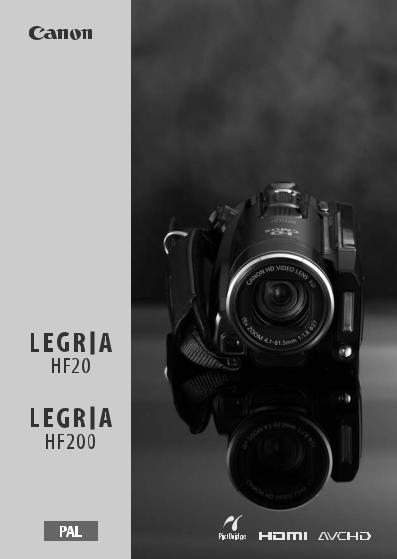
PUB. DIE-0325-000
Digital Video Camcorder
Instruction Manual
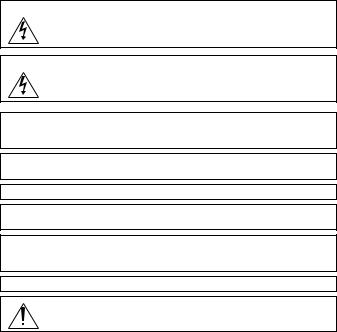
Important Usage Instructions
WARNING!
TO REDUCE THE RISK OF ELECTRIC SHOCK, DO NOT REMOVE COVER (OR BACK). NO USER SERVICEABLE PARTS INSIDE. REFER SERVICING TO QUALIFIED SERVICE PERSONNEL.
WARNING!
TO REDUCE THE RISK OF FIRE OR ELECTRIC SHOCK, DO NOT EXPOSE THIS PRODUCT TO RAIN OR MOISTURE.
CAUTION:
TO REDUCE THE RISK OF ELECTRIC SHOCK AND TO REDUCE ANNOYING INTERFERENCE, USE THE RECOMMENDED ACCESSORIES ONLY.
CAUTION:
DISCONNECT THE MAINS PLUG FROM THE SUPPLY SOCKET WHEN NOT IN USE.
To reduce the risk of electric shock, do not expose this product to dripping or splashing.
The Mains plug is used as the disconnect device. The Mains plug shall remain readily operable to disconnect the plug in case of an accident.
While using the compact power adapter, do not wrap it or cover it with a piece of cloth, and do not place it in confined narrow spaces. Heat may build up, the plastic case may deform and it could result in electric shock or fire.
CA-570 identification plate is located on the bottom.
Using any device other than the Compact Power Adapter CA-570 may damage the camcorder.
2
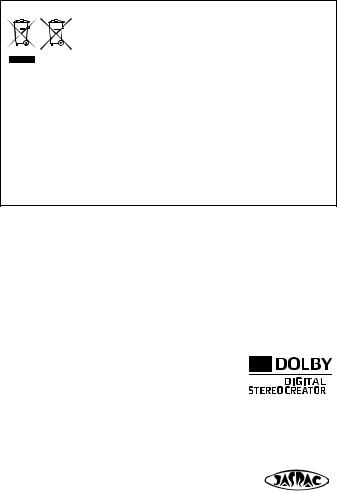
European Union (and EEA) only.
These symbols indicate that this product is not to be disposed of with your household waste, according to the WEEE Directive (2002/96/EC),
the Battery Directive (2006/66/EC) and/or your national laws implementing those Directives.
This product should be handed over to a designated collection point, e.g., on an authorized one-for-one basis when you buy a new similar product or to an authorized collection site for recycling waste electrical and electronic equipment (EEE) and batteries and accumulators. Improper handling of this type of waste could have a possible impact on the environment and human health due to potentially hazardous substances that are generally associated with EEE. Your cooperation in the correct disposal of this product will contribute to the effective usage of natural resources.
For more information about the recycling of this product, please contact your local city office, waste authority, approved scheme or your household waste disposal service or visit www.canon-europe.com/environment.
(EEA: Norway, Iceland and Liechtenstein)
Trademark Acknowledgements
•The SD logo is a trademark. The SDHC logo is a trademark.
•Microsoft, Windows and Windows Vista are trademarks or registered trademarks of Microsoft Corporation in the United States and/or other countries.
•Macintosh and Mac OS are trademarks of Apple Inc., registered in the U.S. and other countries.
•x.v.Colour and the x.v.Colour logo are trademarks.
•HDMI, the HDMI logo and High-Definition Multimedia Interface are trademarks or registered trademarks of HDMI Licensing LLC.
•“AVCHD” and the “AVCHD” logo are trademarks of Panasonic Corporation and Sony Corporation.
•Manufactured under license from Dolby Laboratories.
“Dolby” and the double-D symbol are trademarks of Dolby Laboratories.
•Other names and products not mentioned above may be trademarks or registered trademarks of their respective companies.
•This product is licensed under AT&T patents for the MPEG-4 standard and may be used for encoding MPEG-4 compliant video and/or decoding MPEG-4 compliant video that was encoded only (1) for a personal and noncommercial purpose or (2) by a video provider licensed under the AT&T patents to provide MPEG-4 compliant video. No license is granted or implied for any other use for MPEG-4 standard.
•About the music files License number: R-0801324 Composer: Keita Miyahara
Track names: The new legend, Speed rock, Amazing story, Hit the ceiling, The techno light.
3
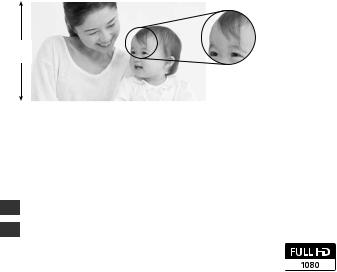
Enjoying High-Definition Video with your Camcorder
Preserve your most treasured memories, be it unforgettable scenery or cherished moments spent with family and friends, with high-definition video recordings of a quality second only to actually being there.
What is High-Definition Video?
1,080 lines
Capture the finest detail, like the movement or shine of a single strand of hair
Your camcorder features a full high-definition image sensor (Full HD CMOS) that captures video at a resolution of 1,920 x 1,080 pixels1. This results in video recordings of unparalleled high quality, fine detail and lifelike vivid colors.
How does full high definition compare with standard-definition TV broadcasts?
5Approximately 5 times the number of pixels.
1.9Almost 90% more scanning lines.
“Full HD 1080” refers to Canon camcorders compliant with high-definition video composed of 1,080 vertical pixels (scanning lines).
1Video is recorded at this resolution only when the recording mode is set to MXP or FXP mode. In other recording modes, the picture is recorded at 1,440 x 1,080 pixels.
4

What are the advantages of flash memory?
Your videos and photos are recorded in the built-in memory ( only) or on commercially available SD/SDHC memory cards2 using AVCHD specifications3. Recording on flash memory means that there are no moving parts in the recorder unit of the camcorder. To you, it means a camcorder that is smaller, lighter and faster. In fact, using the Quick Start function
only) or on commercially available SD/SDHC memory cards2 using AVCHD specifications3. Recording on flash memory means that there are no moving parts in the recorder unit of the camcorder. To you, it means a camcorder that is smaller, lighter and faster. In fact, using the Quick Start function
( 44) you can open the LCD panel and start recording within approximately one second.
44) you can open the LCD panel and start recording within approximately one second.
Any New Functions?
Pre-recording When pre-recording ( 64) is activated, the camcorder starts recording video continuously into a temporary 3-second memory. When you press the START/STOP button, the scene recorded will have started 3 seconds before you started shooting. This is especially useful when it is difficult to predict when to start recording.
64) is activated, the camcorder starts recording video continuously into a temporary 3-second memory. When you press the START/STOP button, the scene recorded will have started 3 seconds before you started shooting. This is especially useful when it is difficult to predict when to start recording.
Face Detection With face detection ( 68), have the camcorder automatically detect people's faces and use this information to adjust the focus and set the best exposure for beautiful videos and photos.
68), have the camcorder automatically detect people's faces and use this information to adjust the focus and set the best exposure for beautiful videos and photos.
Video Snapshot Discover a new fun way to shoot video with video snapshot scenes ( 62). Shoot short (approx. 4-second) scenes and arrange them into a video clip set to your favorite background music.
62). Shoot short (approx. 4-second) scenes and arrange them into a video clip set to your favorite background music.
Cinema Mode Give your recordings a cinematic look by using the [  Cine Mode] recording program (
Cine Mode] recording program ( 61) with the 25 fps progressive frame rate.
61) with the 25 fps progressive frame rate.
2For details about memory cards that can be used with this camcorder refer to
Using a Memory Card (  37).
37).
3AVCHD is the new standard for recording high-definition video. With AVCHD specifications, the video signal is recorded using MPEG-4 AVC/H.264 compression and the audio signal is recorded in Dolby Digital.
5
Can I play back my high-definition video on other devices?
Needless to say, you can connect your camcorder to an HDTV to enjoy your recordings with family and friends ( 116). You also have the following options:
116). You also have the following options:
•You can easily play back video recorded on the memory card by inserting the memory card directly into AVCHD-compatible TV sets
and HDD or DVD recorders that feature an SD/SDHC memory card slot4. For details, refer to the instruction manual of your TV or digital video recorder.
•You can play back AVCHD discs of your recordings created using the
optional DW-100 DVD Burner ( 118) on the DVD Burner itself or on AVCHD-compatible DVD players or Blu-ray Disc players5.
118) on the DVD Burner itself or on AVCHD-compatible DVD players or Blu-ray Disc players5.
4Depending on the device used, correct playback may not be possible even if the device is AVCHD-compatible. In such case, play back the recordings on the
memory card using the camcorder.
5AVCHD discs containing scenes recorded in MXP mode cannot be created with the optional DW-100 DVD burner. Use the software on the supplied Video Tools CD-ROM to back up such scenes.
6
7

Table of contents
Introduction
4 Enjoying High-Definition Video with your Camcorder
12 About this Manual
14Getting to Know the Camcorder
14Supplied Accessories and CD-ROMs
16Names of Parts
19Screen Displays
Preparations
23Getting Started
23 Attaching the Ferrite Core
23 Charging the Battery Pack
26 Preparing the Wireless Controller and Accessories
28Adjusting the Position and Brightness of the LCD Screen
30 Basic Operation of the Camcorder
30 Operating Modes
32 Joystick and Joystick Guide
32 Using the Menus
35 First Time Settings
35Setting the Date and Time
36Changing the Language
36Changing the Time Zone
37Using a Memory Card
37Memory Cards Compatible for Use with the Camcorder
38Inserting and Removing a Memory Card
39 Selecting the Memory for the Recordings
Selecting the Memory for the Recordings
39Initializing the Built-in Memory ( only) or Memory Card
only) or Memory Card
8 Table of contents

Video
41Basic Recording
41Shooting Video
42Selecting the Video Quality (Recording Mode)
43Zooming
44Quick Start Function
46 Basic Playback
46 Playing Back the Video
48Selecting what Recordings to Play Back
49Searching for Scenes
51 Selecting the Playback Starting Point
53 Pre-selecting Recordings from the Index Screen
55 Deleting Scenes
57 Advanced Functions
57 Special Scene Recording Programs
59 Changing the Shutter Speed and Aperture
61Cinema Mode: Giving a Cinematic Look to your Recordings
61Mini Video Light
62Video Snapshot
64Pre-recording Function
65Self Timer
66Manual Exposure Adjustment and Automatic Backlight Correction
67Manual Focus Adjustment
68Face Detection
69White Balance
71Image Effects
72Digital Effects
73On-Screen Displays and Data Code
74Audio Recording Level
75Using Headphones
77 Using the Mini Advanced Shoe
77 Using an External Microphone
Table of contents 9

79Playlist and Scene Operations
79Dividing Scenes
80Editing the Playlist: Adding, Deleting, Moving and Playing Back
84 Copying Scenes
Copying Scenes
Photos
86Basic Recording
86Taking Photos
87Selecting Photo Size and Quality
88Deleting a Photo Right After Recording It
89Basic Playback
89Viewing Photos
90Deleting Photos
92Magnifying Photos during Playback
93Additional Functions
93Flash
94Drive Mode: Continuous Shooting and Exposure Bracketing
95Taking Photos while Recording Movies (Simultaneous Recording)
96Light Metering Mode
97Slideshow
98Rotating Photos
98Histogram Display
99Capturing Photos from the Playback Scene
100Protecting Photos
101 Copying Photos
Copying Photos
104 Printing Photos
104 Printing Photos (Direct Print)
106 Selecting the Print Settings
108Trimming Settings
109Print Orders
10 Table of contents

External Connections
112Terminals on the Camcorder
113Connection Diagrams
116Playback on a TV Screen
117Saving Your Recordings
117Saving Your Recordings on a Computer
118Authoring High-Definition (AVCHD) Discs and Photo DVDs
122Copying your Recordings to an External Video Recorder
123Transferring Photos to a Computer (Direct Transfer)
127Transfer Orders
Additional Information
129Appendix: Menu Options Lists
129 FUNC. Menu
132 Setup Menus
143 |
Trouble? |
143 |
Troubleshooting |
148 |
List of Messages |
158 |
Do’s and Don’ts |
158 |
Handling Precautions |
163Maintenance/Others
164Using the Camcorder Abroad
165General Information
165System Diagram
166Optional Accessories
171 |
Specifications |
175 |
Index |
Table of contents 11

About this Manual
Thank you for purchasing the Canon LEGRIA HF20/LEGRIA HF200. Please read this manual carefully before you use the camcorder and retain it for future reference. Should your camcorder fail to operate correctly, refer to Troubleshooting (  143).
143).
Conventions Used in this Manual
• IMPORTANT: Precautions related to the camcorder’s operation.
IMPORTANT: Precautions related to the camcorder’s operation.
• NOTES: Additional topics that complement the basic operating procedures.
NOTES: Additional topics that complement the basic operating procedures.
• POINTS TO CHECK: Restrictions or requirements regarding the function described.
POINTS TO CHECK: Restrictions or requirements regarding the function described.
• : Reference page number within this manual.
: Reference page number within this manual.
To complete some operations you will need to refer also to other instruction manuals. This will be indicated with the following icons:
DVSD Refer to the ‘Digital Video Software’ instruction manual, included as a PDF file in the supplied DIGITAL VIDEO Solution Disk CD-ROM.
DW-100 Refer to the instruction manual of the optional DW-100 DVD Burner.
• : Text that applies only to the model shown in the icon.
: Text that applies only to the model shown in the icon.
•The following terms are used in this manual:
When not specified as “memory card” or “built-in memory”, the term “memory” by itself refers to both.
“Scene” refers to one movie unit from the point you press the START/STOP button to start recording until you press again to pause the recording.
•The photos included in this manual are simulated pictures taken with a still camera. Unless indicated otherwise, illustrations and menu icons refer to the  .
.
12 Introduction
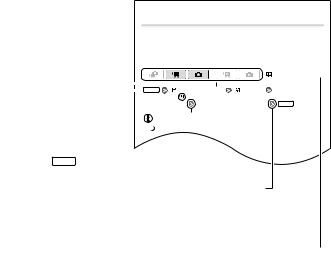
Advanced Functions
Special Scene Recording Programs
Recording in a very bright ski resort or capturing the full colors of a sunset or a fireworks display becomes as easy as selecting a Special Scene recording program. For details about the available options, refer to the following sidebar.
|
|
|
|
|
|
|
|
|
|
|
|
|
|
|
|
|
|
|
|
|
|
|
( |
|
|
30) |
|
|
||||||
Brackets [ ] are used to refer to |
|
|
|
|
|
|
|
|
|
|
|
|
|
|
|
|
|
|
|
|
|
|
|
|
|
|
|
|
|
|
|
|
|
|
|
|
|
|
|
|
|
|
|
|
|
|
|
|
|
|
|
|
|
|
|
|
|
|
|
|
|
|
|
|
|
||||
|
|
|
|
|
|
|
|
|
|
|
|
|
|
|
|
|
|
|
|
|
|
|
|
|
|
|
|
|
|
|
|
|
||
menu options as they are |
|
FUNC. |
|
|
|
[ |
|
Programmed AE] |
|
[ |
|
Portrait] |
|
|
|
|
|
|
|
|
|
|||||||||||||
|
|
|
|
|
|
|
|
|
|
|
|
|
|
|
|
|||||||||||||||||||
|
|
|
|
|
|
|
|
|
|
|
|
|
|
|
|
|
|
|
|
|
|
|
|
|
|
|
|
|
|
|
|
|||
|
|
|
Press |
|
|
to display the Special Scene (SCN) recording |
||||||||||||||||||||||||||||
displayed on screen. |
|
|
|
|
|
|
||||||||||||||||||||||||||||
|
|
|
|
|
|
|
|
|
|
|
|
|
|
|
|
|
|
|
|
|
|
|
|
|
|
|
|
|
|
|
|
|||
|
|
|
programs |
|
|
|
Desired recording program |
|
|
|
|
FUNC. |
|
|
||||||||||||||||||||
|
|
|
|
|
|
|
|
|
|
|
|
|
|
|
|
|
|
|
|
|
|
|
|
|
|
|
|
|
|
|
|
|
|
|
|
|
|
|
NOTES |
|
|
|
|
|
|
|
|
|
|
|
|
|
|
|
|
|
|
|
|
|
|
|
|||||||
|
|
|
|
|
|
|
|
|
|
|
|
|
|
|
|
|
|
|
|
|
|
|
|
|
|
|
|
|
|
|
|
|
|
|
The names of most buttons and |
|
|
• [ |
|
Night]: |
|
|
|
|
|
|
|
|
|
|
|
|
|
|
|
|
|
|
|
|
|
|
|
||||||
|
|
|
|
|
|
|
|
|
|
|
|
|
|
|
|
|
|
|
|
|
|
|
|
|
|
|||||||||
|
|
|
|
|
|
|
|
|
|
|
|
|
|
|
|
|
|
|
|
|
|
|
|
|
|
|
|
|
|
|
|
|
||
- Moving subjects may leave a trailing afterimage. |
|
|
|
|
|
|
||||||||||||||||||||||||||||
|
|
|
|
|
|
|
||||||||||||||||||||||||||||
switches are indicated within a |
|
|
|
|
|
|
||||||||||||||||||||||||||||
- Picture quality may not be as good as in other modes. |
||||||||||||||||||||||||||||||||||
“button” frame. |
- White points may appear on the screen. |
|
|
|
|
|
|
|||||||||||||||||||||||||||
- Autofocus may not work as well as in other modes. In such case, |
||||||||||||||||||||||||||||||||||
For example FUNC. . |
||||||||||||||||||||||||||||||||||
|
adjust the focus manually. |
|
|
|
|
|
|
|||||||||||||||||||||||||||
In this manual, the  arrow is used to abbreviate menu selections. For a detailed explanation refer to Using the Menus (
arrow is used to abbreviate menu selections. For a detailed explanation refer to Using the Menus (  32).
32).
In this manual,  indicates that a function is available in the operating mode
indicates that a function is available in the operating mode  indicated and
indicated and  indicates that the function is not available. For a detailed explanation refer to Operating Modes (
indicates that the function is not available. For a detailed explanation refer to Operating Modes (  30).
30).
Introduction 13

Supplied Accessories and CD-ROMs
The following accessories are supplied with the camcorder:
XCA-570 Compact Power Adapter
(incl. power cord and ferrite core)
BP-809 Battery PackW
XWL-D88 Wireless Controller
(incl. CR2025 lithium button battery)
STV-250N Stereo Video CableW
Yellow • Red • White plugs
XCTC-100/S Component Cable
Red • Green • Blue plugs
IFC-400PCU USB CableW
XWS-30 Wrist Strap
Quick GuideW
14 Introduction
The following CD-ROMs and software are supplied with the camcorder:
•PIXELA Application - Disc 1 CD-ROM* and ‘PIXELA ImageMixer 3 SE’ Installation Guide
-ImageMixer 3 SE Transfer Utility – Software for saving and transferring movies.
-Music Transfer Utility – Software for transferring to the camcorder music data for video snapshot playback.
•PIXELA Application - Disc 2 CD-ROM*
-ImageMixer 3 SE Video Tools – Software for managing, editing, and playing back movies.
•DIGITAL VIDEO Solution Disk CD-ROM* – Software for saving, managing, and printing photos.
• Instruction Manual/Music Data CD-ROM – Contains the full-ver- sion instruction manual of the camcorder (this PDF file) and music files that can be used as background music during playback.
Instruction Manual/Music Data CD-ROM – Contains the full-ver- sion instruction manual of the camcorder (this PDF file) and music files that can be used as background music during playback.
The music files on this CD-ROM are for exclusive use with the supplied PIXELA applications, Music Transfer Utility and ImageMixer 3 SE Video Tools. For more details, refer to the ‘Music Transfer Utility Software Guide’ and ‘ImageMixer 3 SE Software Guide’ on the PIXELA Application - Disc 1 CD-ROM.
* The CD-ROM includes the instruction manual of the software (on PDF file).
Introduction 15
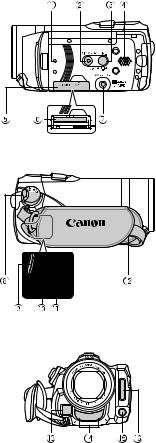
Names of Parts
Left side view
Right side view
Front view
 RESET button (
RESET button (  146)
146)
 VIDEO SNAP (video snapshot) button (
VIDEO SNAP (video snapshot) button (  62)/
62)/

 (print/share) button (
(print/share) button (  105, 125)
105, 125)
 DISP. (on-screen display) button (
DISP. (on-screen display) button (  73)/
73)/
BATT. INFO button (  22)
22)  Speaker (
Speaker (  46)
46)
 Memory card slot cover
Memory card slot cover
 Memory card slot (
Memory card slot (  38)
38)
 AV OUT terminal (
AV OUT terminal (  112, 114)/
112, 114)/
 (headphones) terminal (
(headphones) terminal (  75)
75)
 Camera mode dial (
Camera mode dial (  30)
30)
 Strap mount (
Strap mount (  27)
27)
 USB terminal (
USB terminal (  112, 115)
112, 115)
 HDMI OUT terminal (
HDMI OUT terminal (  112, 113)
112, 113)
 Grip belt (
Grip belt (  27)
27)
 Instant AF sensor (
Instant AF sensor (  134)
134)
 Stereo microphone (
Stereo microphone (  74)
74)
 Mini video light (
Mini video light (  61)
61)  Flash (
Flash (  93)
93)
16 Introduction
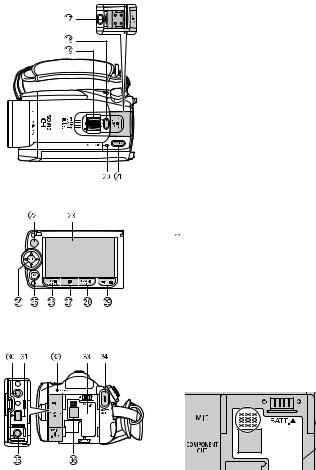
Top view
LCD panel
Back view
 Mini advanced shoe (
Mini advanced shoe (  77)
77)
 PHOTO button (
PHOTO button (  86)
86)
 Zoom lever (
Zoom lever (  43)
43)
 ON/OFF (CHG) (charge) indicator: Green – ON
ON/OFF (CHG) (charge) indicator: Green – ON
Orange – Standby (  44) Red – Charging (
44) Red – Charging (  23)
23)
 POWER button
POWER button
 Remote sensor (
Remote sensor ( 26)
26)
 LCD screen (
LCD screen ( 28)
28)
 Joystick (
Joystick ( 32)
32)
 FUNC. button (
FUNC. button ( 33, 129)
33, 129)

 /
/ (play/pause) button (
(play/pause) button ( 46)/ START/STOP button (
46)/ START/STOP button ( 41)
41)

 (stop) button (
(stop) button ( 46)/
46)/
Zoom out W (wide-angle) button ( 43)
43)
 PLAYLIST button (
PLAYLIST button ( 80)/
80)/
Zoom in T (telephoto) button ( 43)
43) 


 (camera/play) button (
(camera/play) button ( 31)
31)  MIC terminal (
MIC terminal ( 78)
78)
 COMPONENT OUT terminal (
COMPONENT OUT terminal ( 112, 114)
112, 114)
 ACCESS indicator (
ACCESS indicator ( 41, 86)
41, 86)
 Battery attachment unit (
Battery attachment unit ( 23)
23)
 START/STOP button (
START/STOP button ( 41)
41)
 DC IN terminal (
DC IN terminal ( 23)
23)
 Serial number
Serial number
The serial number label is located in the battery attachment unit. Remove the battery pack to find it.
Introduction 17
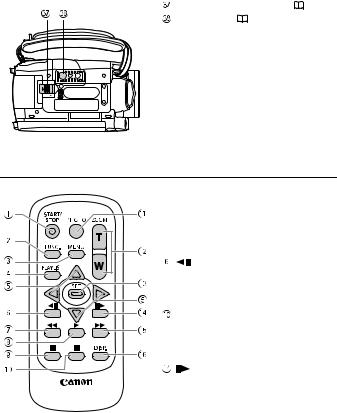
Bottom view |
BATTERY RELEASE switch ( 24) |
|
|
|
Tripod socket ( 158) |
Wireless Controller WL-D88
 START/STOP button (
START/STOP button (  41)
41)
 FUNC. button (
FUNC. button (  33, 129)
33, 129)
 MENU button (
MENU button (  33, 132)
33, 132)
 PLAYLIST button (
PLAYLIST button (  80)
80)
 Navigation buttons (
Navigation buttons (  /
/  /
/  /
/  )
)
(frame reverse) button (  47)
47)

 (fast reverse) button (
(fast reverse) button (  47)
47)

 (play) button (
(play) button (  46)
46)

 (pause) button (
(pause) button (  46)
46)
 (stop) button (
(stop) button (  46)
46)
 PHOTO button (
PHOTO button (  86)
86)
 Zoom buttons (
Zoom buttons (  43)
43)
 SET button
SET button
(frame advance) button (  47)
47)

 (fast forward) button (
(fast forward) button (  47)
47)  DISP. (on-screen display) button
DISP. (on-screen display) button
(  73)
73)
18 Introduction
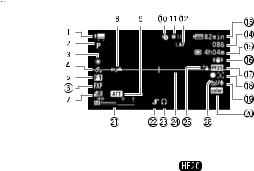
Screen Displays
 Recording Movies
Recording Movies
 Operating mode (
Operating mode (  30)
30)
 Recording program (
Recording program (  57, 59, 61)
57, 59, 61)
 White balance (
White balance (  69)
69)
 Image effect (
Image effect (  71)
71)
 Digital effect (
Digital effect (  72)
72)
 Recording mode (
Recording mode (  42)
42)
 Photo quality/size
Photo quality/size
(simultaneous recording) (  95)
95)  Remote sensor off (
Remote sensor off (  139)
139)
 Microphone attenuator (
Microphone attenuator (  135)
135)
 Pre-recording (
Pre-recording (  64)
64)
 Memory operation (
Memory operation (  22)
22)

 Instant AF (
Instant AF (  134), MF Manual focus (
134), MF Manual focus (  67)
67)
 Remaining battery time (
Remaining battery time (  22)
22)
 While recording/during playback: Scene counter (hours : minutes : seconds)
While recording/during playback: Scene counter (hours : minutes : seconds)
In record pause mode: Total number of scenes
 Remaining recording time
Remaining recording time
 On the memory card
On the memory card
 In the built-in memory
In the built-in memory
 Image stabilizer (
Image stabilizer (  134)
134)
 25F progressive frame rate (
25F progressive frame rate (  22, 61)
22, 61)
 Face detection (
Face detection (  68)
68)
 Wind screen off (
Wind screen off (  135)
135)
 x.v.ColourTM (
x.v.ColourTM (  132)
132)
 Audio level indicator (
Audio level indicator (  74)
74)  Mini advanced shoe (
Mini advanced shoe (  77)
77)
 Headphone output (
Headphone output (  75)
75)  Level marker (
Level marker (  136)
136)
 Backlight correction (
Backlight correction (  67)
67)  Mini video light (
Mini video light (  61)
61)
Introduction 19

 Recording Photos
Recording Photos
 Zoom (
Zoom (  43),
43),
Exposure 



 (
(  66)
66)  Light metering mode (
Light metering mode (  96)
96)  Drive mode (
Drive mode (  94)
94)
 Photo quality/size (
Photo quality/size (  87)
87)  Self timer (
Self timer (  65)
65)
 Playing Movies (During Playback)
Playing Movies (During Playback)
 Data code (
Data code (  73, 136)
73, 136)
 Scene number
Scene number
 Number of available photos
Number of available photos
 On the memory card
On the memory card
 In the built-in memory
In the built-in memory
 Camcorder shake warning (
Camcorder shake warning (  134)
134)
 AF frame (
AF frame (  134)
134)
 Focus and exposure lock (
Focus and exposure lock (  86)
86)  Flash (
Flash (  93)
93)
 Joystick guide (
Joystick guide (  32)
32)
20 Introduction
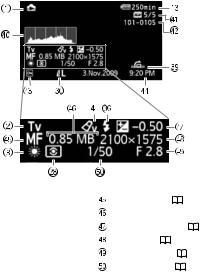
 Viewing Photos
Viewing Photos
 Histogram (
Histogram ( 98)
98)
 Current photo / Total number of photos
Current photo / Total number of photos
 Photo number (
Photo number ( 140)
140)
 Protected photo mark (
Protected photo mark ( 100)
100)  Date and time of recording
Date and time of recording
Manual focus ( |
|
67) |
File size |
|
|
Manual exposure ( |
66) |
|
Photo size ( |
87) |
|
Aperture value ( |
59) |
|
Shutter speed ( |
|
59) |
Introduction 21

|
Memory operation |
|
|
|
|||||
|
Record, |
Record pause, |
Playback, |
Playback pause, |
Fast playback, |
||||
|
Fast reverse playback, |
Slow playback, |
Slow reverse playback, |
||||||
|
Frame advance, |
|
|
|
Frame reverse. |
|
|
||
|
|
|
|
|
|||||
 Remaining battery time
Remaining battery time
• The first time you use a battery pack, fully charge it and then use the camcorder until the battery pack is completely exhausted. Doing so will ensure that the remaining recording time will be displayed accurately.
• The icon shows a rough estimate |
100% |
75% |
50% |
25% |
0% |
|
of the remaining charge as a |
||||||
|
|
|
|
|
percentage of the full charge of the battery pack. The remaining
recording/playback time of the battery pack is displayed, in minutes, next to the icon.
•When  is displayed in red, replace the battery pack with a fully charged one.
is displayed in red, replace the battery pack with a fully charged one.
•When you attach an empty battery pack, the power may turn off without displaying  .
.
•Depending on the conditions under which the camcorder and the battery pack are used, the actual battery charge may not be indicated accurately.
•When the camcorder is off, press BATT.INFO to display the charge status of a battery pack. The Intelligent System will display the charge status (as a percentage) and the remaining recording time (in minutes) for 5 seconds. If the battery pack is exhausted, the battery information may not be displayed.
 Remaining recording time
Remaining recording time
When there is no more free space on the memory, “ End” (built-in memory,
End” (built-in memory,  only) or “
only) or “ End” (memory card) will be displayed and the recording will stop.
End” (memory card) will be displayed and the recording will stop.
 25F progressive frame rate
25F progressive frame rate
Select the 25F progressive frame rate ( 61) to give your recordings a cinematic look. You can combine this frame rate with the [
61) to give your recordings a cinematic look. You can combine this frame rate with the [  Cine Mode] recording program to enhance the effect.
Cine Mode] recording program to enhance the effect.
 Number of available photos
Number of available photos
 in red: There is no memory card in the camcorder.
in red: There is no memory card in the camcorder.
 in green: 6 or more photos
in green: 6 or more photos  in yellow: 1 to 5 photos
in yellow: 1 to 5 photos  in red: No more photos can be recorded.
in red: No more photos can be recorded.
•When viewing the photos, the display will always be in green.
•Depending on the recording conditions, the number of available photos displayed may not decrease even after a recording has been made, or may decrease by 2 photos at once.
22 Introduction

Preparations
This chapter describes basic operations, such as navigating the menus, and first time settings to help you learn more about your camcorder.
Getting Started
Attaching the Ferrite Core
Attach the enclosed ferrite core before you connect the compact power adapter to the camcorder.
Attach the ferrite core to the cable about 4 cm from the plug end (the plug to be connected to the camcorder) of the compact power adapter cable.
Pass the cable through the center of the core and wrap it around the core, then close the unit until it clicks shut.
Charging the Battery Pack
The camcorder can be powered with a battery pack or directly using the compact power adapter. Charge the battery pack before use. For approximate charging times and recording/playback times with a fully charged battery pack, refer to the tables on pages 166-168.
Preparations 23
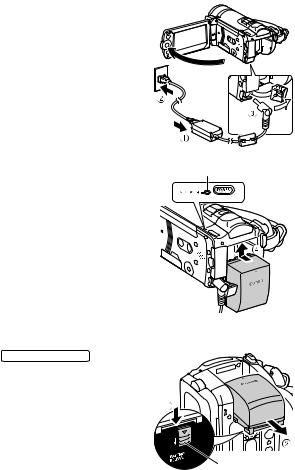
1Connect the power cord to the compact power adapter.
2 Plug the power cord into a power outlet.
3Connect the compact power adapter to the camcorder’s DC IN terminal.
4Attach the battery pack to the camcorder.
Press the battery pack softly into the battery attachment unit and slide it up until it clicks in place.
5Charging will start when the camcorder is turned off.
•If the camcorder was on, the green ON/OFF (CHG) indicator will go out when you turn off the camcorder.
After a moment, the ON/OFF (CHG) indicator will start flashing in red (battery pack charging). The red ON/ OFF (CHG) indicator will go out when the battery pack is fully charged.
•If the indicator flashes quickly, refer to
Troubleshooting (  143).
143).
To remove the battery pack
1Slide BATTERY RELEASE in the direction of the arrow and hold it pressed down.
2Slide the battery pack down and then pull it out.
DC IN 
 terminal
terminal 

ON/OFF (CHG) (charge) indicator
BATTERY RELEASE switch
24 Preparations

 IMPORTANT
IMPORTANT
•Turn off the camcorder before connecting or disconnecting the compact power adapter. After pressing POWER to turn off the camcorder, important data is updated in the memory. Be sure to wait until the green ON/OFF (CHG) indicator goes out.
•We recommend charging the battery pack in temperatures between 10 °C and 30 °C. Outside the temperature range of 0 °C to 40 °C, charging will not start.
•Do not connect to the camcorder’s DC IN terminal or to the compact power adapter any electrical equipment that is not expressly recommended for use with this camcorder.
•To prevent equipment breakdowns and excessive heating, do not connect the supplied compact power adapter to voltage converters for overseas travels or special power sources such as those on aircraft and ships, DC-AC inverters, etc.
 NOTES
NOTES
•The battery pack will be charged only when the camcorder is off.
•If remaining battery time is an issue, you can power the camcorder using the compact power adapter so the battery pack will not be consumed.
•Charged battery packs continue to discharge naturally. Therefore, charge them on the day of use, or the day before, to ensure a full charge.
•We recommend that you prepare battery packs to last 2 to 3 times longer than you think you might need.
Preparations 25

Preparing the Wireless Controller and Accessories
First, insert the supplied CR2025 lithium button battery into the wireless controller.
1 Press the tab in the direction of the arrow and pull out the battery holder.
2Place the lithium button battery with the + side facing up.
3 Insert the battery holder.
Tab
To use the wireless controller
Point the wireless controller at the camcorder’s remote sensor when you press the buttons.
You can rotate the LCD panel 180 degrees to use the wireless controller from the front of the camcorder.
 NOTES
NOTES
•The wireless controller may not work properly when the remote sensor is situated under strong light sources or direct sunlight.
•If the wireless controller does not work, check that 
 [Wireless Remote Control] is not set to [
[Wireless Remote Control] is not set to [  Off
Off  ] (
] (  139). Otherwise, replace the battery.
139). Otherwise, replace the battery.
26 Preparations
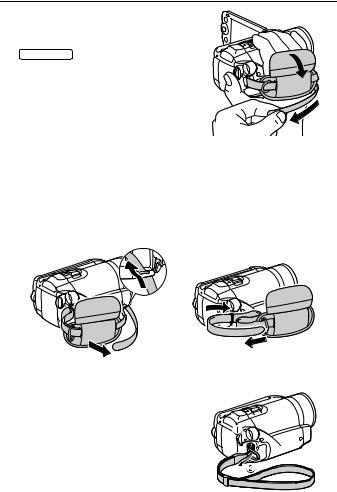
Accessories
Fasten the grip belt.
Adjust the grip belt so that you can reach the zoom lever with your index finger, and the START/STOP button with your thumb.
To remove the grip belt
1Lift the padded handgrip's flap and detach the strap from the Velcro pad.
2Pull the strap to remove it first from the front bracket on the camcorder, then to unthread it from the handgrip and finally to remove it from the rear bracket on the camcorder.
To attach the wrist strap
Pass the attaching end of the wrist strap through the back bracket on the camcorder, thread the wrist strap through the loop and fasten.
You can also attach the wrist strap to the strap mount on the grip belt to use both for extra convenience and protection.
Preparations 27
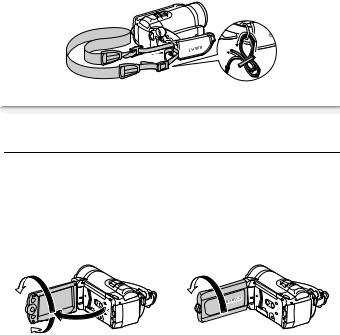
To attach a shoulder strap
Pass the ends of the shoulder strap through the strap mount on the grip belt and adjust the length of the strap.
Adjusting the Position and Brightness of the LCD Screen
Rotating the LCD Panel
Open the LCD panel 90 degrees.
•You can rotate the panel 90 degrees downward.
•You can rotate the panel 180 degrees toward the lens. Rotating the LCD panel 180 degrees can be useful in the following cases:
-To include yourself in the picture when recording with the self timer.
-To allow the camcorder to be operated with the wireless controller from the front.
180° |
180° |
90° |
Subject can monitor the LCD screen |
 NOTES
NOTES
•About the LCD screen: The screen is produced using extremely high-pre- cision manufacturing techniques, with more than 99.99% of the pixels operating to specification. Less than 0.01% of the pixels may occasionally misfire or appear as black, red, blue or green dots. This has no effect on the recorded image and does not constitute a malfunction.
28 Preparations
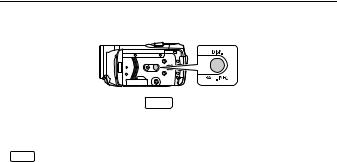
LCD Backlight
When recording in bright places it may be difficult to use the LCD screen. Turn on the LCD backlight to make it brighter.
With the camcorder on, hold DISP. pressed down for more than 2 seconds.
•Repeat this action to turn the LCD backlight on (bright) or off (normal).
•If 
 [LCD Screen Dimmer] is set to [
[LCD Screen Dimmer] is set to [  On] (
On] ( 138), pressing DISP. for more than 2 seconds will turn off the screen dimmer and
138), pressing DISP. for more than 2 seconds will turn off the screen dimmer and
return the LCD screen to its previous brightness setting.
 NOTES
NOTES
•The LCD backlight does not affect the brightness of the recordings.
•Using the bright setting will shorten the effective usage time of the battery pack.
•You can further adjust the brightness of the LCD screen with the 
 [LCD Brightness] setting (
[LCD Brightness] setting (  138), or dim it with the
138), or dim it with the 
 [LCD Screen Dimmer] setting (
[LCD Screen Dimmer] setting (  138) to use in places where the light from the LCD screen can be a nuisance.
138) to use in places where the light from the LCD screen can be a nuisance.
Preparations 29
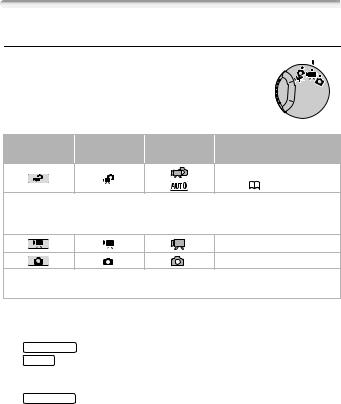
Basic Operation of the Camcorder
Operating Modes
Recording
When recording video or photos, the camcorder’s operating mode is determined by the position of the camera mode dial.
Operating |
Camera mode |
Onscreen icon |
Operation |
|
mode |
dial |
|||
|
|
|||
|
|
Easy recording of movies and |
||
|
|
photos ( |
41, 86). |
|
Dual Shot Record video and take photos easily, letting the camcorder take care of all the settings – Great for beginners or if you just prefer not to bother with detailed camcorder settings.
Recording movies (  41).
41).
Recording photos (  86).
86).
Flexible recording Use one of the dedicated recording modes to enjoy full access to the menus and advanced functions and change the camcorder’s settings to your preference.
 NOTES
NOTES
•Only the following buttons/functions are available in  mode.
mode.
-START/STOP for recording movies.
-PHOTO for recording photos.
-Zoom lever and zoom buttons on the LCD panel (  43).
43).
-Quick Start (  44).
44).
-VIDEO SNAP video snapshot ( 62).
62).
30 Preparations
